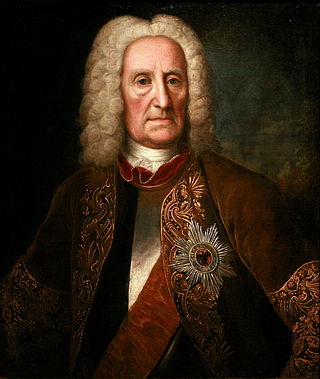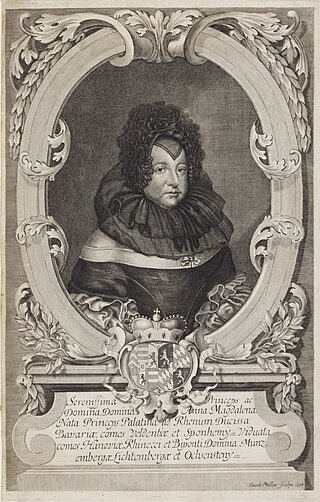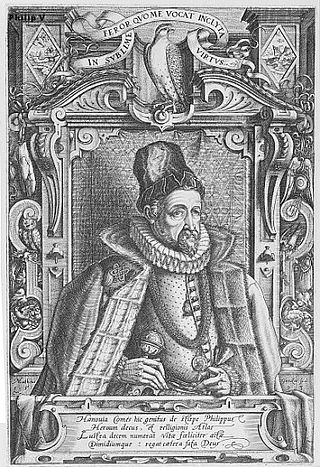
The County of Hanau was a territory within the Holy Roman Empire, evolved out of the Lordship of Hanau in 1429. From 1456 to 1642 and from 1685 to 1712 it was divided into the County of Hanau-Münzenberg and the County of Hanau-Lichtenberg. After both lines became extinct the County of Hanau-Münzenberg was inherited by the Landgraviate of Hesse-Kassel, the County of Hanau-Lichtenberg by the Landgraviate of Hesse-Darmstadt in 1736.

Johann Reinhard III of Hanau-Lichtenberg was the last of the counts of Hanau-Lichtenberg. He reigned from 1680 to 1736. From 1712 to 1736, he also reigned the County of Hanau-Münzenberg.

Countess Charlotte of Hanau-Lichtenberg, full name: Countess Charlotte Christine Magdalene Johanna of Hanau-Lichtenberg was the wife of landgrave Louis VIII of Hesse-Darmstadt.

Count Johann Reinhard II of Hanau-Lichtenberg was a younger son of Count Philipp Wolfgang of Hanau-Lichtenberg (1595–1641) and Countess Johanna of Oettingen-Oettingen.

Countess Palatine Anna Magdalena of Birkenfeld-Bischweiler was a daughter of Christian I, Count Palatine of Birkenfeld-Bischweiler (1598–1654) and his first wife, Countess Palatine Magdalene Catherine of Zweibrücken (1606–1648).
Philipp Wolfgang was a count of Hanau-Lichtenberg. He ruled the county from 1625 until his death.

Count Johann Reinhard I of Hanau-Lichtenberg ruled the county of Hanau-Lichtenberg from 1599 to 1625.

Philipp Reinhard of Hanau-Münzenberg from 1680 to 1712 in the County of Hanau-Münzenberg.
Philipp III of Hanau-Lichtenberg was the third Count of Hanau-Lichtenberg.

Philipp V of Hanau-Lichtenberg was Count of Hanau-Lichtenberg from 1590 until his death.
Ludowika Margaretha of Zweibrücken-Bitsch, was the only child and heiress of Count James of Zweibrücken-Bitsch by his wife Catherine, born Countess of Honstein zu Klettenberg. She was buried in Ingwiller.
Philipp IV of Hanau-Lichtenberg was from 1538 to 1590 the reigning Count of Hanau-Lichtenberg. Before his accession he had already conducted government business on behalf of his father, Count Philipp III. He was very interested in alchemy.

Friedrich Casimir of Hanau was a member of the Hanau-Lichtenberg branch of the House of Hanau.

Philipp I, Count of Hanau-Lichtenberg was Count of Hanau. The county was divided between him and his nephew, Count Philipp I "the Younger". Philipp the Elder's part of the county was later called Hanau-Lichtenberg; Philipp the Younger's part is known as Hanau-Münzenberg.

Count Philipp I of Hanau-Münzenberg, nicknamed Philipp the Younger, was a son of Count Reinhard III of Hanau and Countess Palatine Margaret of Mosbach. He was the Count of Hanau from 1452 to 1458. The county was then divided between him and his uncle Philipp the Elder. Philipp the Younger received Hanau-Münzenberg and ruled there from 1458 until his death.

Georg II of Fleckenstein Dagstuhl was the last baron of the house of Fleckenstein. He was the eldest son of Philipp Wolfgang of Fleckenstein-Dagstuhl and his first wife, Anna Alexandria of Rappoltstein. Georg II gained considerable power as guardian and regent of the still underage Count Friedrich Casimir and the counties of Hanau-Lichtenberg and Hanau-Münzenberg during the final phases of the Thirty Years' War.
Elisabeth of Hanau was a daughter of Lord Ulrich V and his wife, Countess Elisabeth of Ziegenhain. She died on 25 May 1475 and was buried in the Gnadental monastery in Michelfeld.
Countess Anna Sibylle of Hanau-Lichtenberg was a German noblewoman. She was born in Lichtenberg, the eldest surviving daughter of Count Philipp IV and his wife, Countess Eleonore of Fürstenberg.
The County of Hanau-Münzenberg was a territory within the Holy Roman Empire. It emerged when the County of Hanau was divided in 1458, the other part being the county of Hanau-Lichtenberg. Due to common heirs, both counties were merged from 1642 to 1685 and from 1712 to 1736. In 1736 the last member of the House of Hanau died and the Landgrave of Hessen-Kassel inherited the county.

The County of Zweibrücken-Bitsch was a territory of the Holy Roman Empire that was created between 1286 and 1302 from the eastern part of the County of Zweibrücken and the Barony of Bitche in Lorraine. It existed until 1570, when it was divided amongst its heirs when the counts died out.























